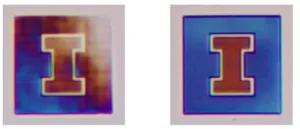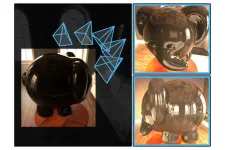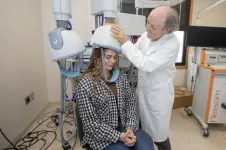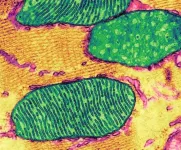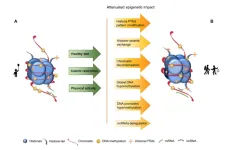(Press-News.org) Respiratory syncytial virus (RSV) is a highly contagious disease that affects millions of people each year around the world, resulting in an estimated 160,000 deaths. In the United States, severe RSV causes 6,000 to 10,000 deaths among people 65 years of age or older.
On May 3, the U.S. Food and Drug Administration approved Arexvy, an RSV vaccine developed by pharmaceutical company GSK plc, formerly GlaxoSmithKline plc. It is the first RSV vaccine to be approved in the United States, and according to GSK’s press release, the first for older adults to be approved anywhere in the world. This is a crucial step toward improving preventative care for this deadly disease.
“The structures we determined at the APS played an important role in the development of this vaccine. The availability of light source facilities such as the APS meant that we could try multiple variants until we hit on the right one that neutralized the virus.” — Jason McLellan, University of Texas at Austin
Although Arexvy has recently been approved, its origins date back more than a decade. GSK’s vaccine is based in part on data collected at the Advanced Photon Source (APS), a U.S. Department of Energy (DOE) Office of Science user facility at DOE’s Argonne National Laboratory, starting in 2009. Those data were collected by Jason McLellan, now a professor at the University of Texas at Austin; Peter Kwong, chief of the structural biology section at the National Institutes of Health (NIH); and Barney Graham, who retired from NIH’s National Institute of Allergy and Infectious Diseases in 2021. (Graham is now the senior advisor for global health equity at Morehouse School of Medicine.)
McLellan was a postdoctoral researcher in Kwong’s lab at NIH from 2008 to 2013. The key to the RSV vaccine he, Kwong and Graham developed was a stronger understanding of the F protein, which sticks out from the surface of the virus and makes first contact with human cells, infecting them. The protein has two conformations: prefusion, a smaller form that first makes contact with cells, and postfusion, an extended form that the protein adopts once it has finished helping the virus into those cells.
Since infection depends on the F protein achieving its postfusion mode, McLellan, Kwong and Graham focused their efforts on stabilizing the protein in its prefusion form. This would provide a target for the immune system, helping it develop neutralizing antibodies against the virus. The researchers created more than 100 different variants of the F protein before they achieved success, and parts of that work were performed at the Southeast Regional Collaborative Access Team (SER-CAT) beamline at the APS, operated by the University of Georgia.
“The structures we determined at the APS played an important role in the development of this vaccine,” McLellan said. “The availability of light source facilities such as the APS meant that we could try multiple variants until we hit on the most stabilized antigen.”
In May 2013, McLellan, Kwong, Graham and their colleagues reported success, publishing their work in Science. In November 2013, they reported a vaccine candidate for RSV that was based on a prefusion-stabilized form of the F protein. When injected into animals, that vaccine candidate elicited exceptionally high levels of neutralizing antibodies. That paper was also published in Science, and included structural work performed at SER-CAT.
“SER-CAT is honored to have played a small but important part in building the groundwork for this momentous lifesaving vaccine,” said B.C. Wang, SER-CAT director. “This work illustrates the importance of making state-of-the-art resources such as SER-CAT available to the nation’s scientists.”
Since then, various permutations of that vaccine have undergone clinical trials. Arexvy is based in part on the vaccine candidate developed by McLellan, Kwong, Graham and their fellow researchers.
In its main clinical trial, Arexvy was administered to approximately 12,500 patients age 60 or older. The vaccine was shown to reduce the risk of developing lower respiratory tract disease (LRTD), a common RSV-related illness, by 82.6 percent, and severe LRTD by 94.1 percent.
“I’m very pleased to see our hard work pay off with an approved vaccine for RSV,” McLellan said. “Vaccine development and approval takes time, but knowing that our research will result in lives saved and severe illnesses avoided is immensely gratifying.”
Since 2013, McLellan and Graham have turned their attention to coronaviruses, applying the same technique they developed for RSV to the infamous spike protein found on coronaviruses. When the COVID-19 pandemic struck in 2020, they joined with other colleagues to apply their method to inhibit the spread of the disease. They discovered that the same principle applied to the spike protein of SARS-CoV-2, the virus that causes COVID-19, and the mutations they developed were incorporated into both Pfizer’s and Moderna’s COVID-19 vaccines.
“The COVID-19 vaccines were developed and approved quickly, but it was this structural biology work by McLellan and his colleagues on other viruses, such as RSV, over more than a decade that helped make them so effective,” said Bob Fischetti, Argonne group leader and life sciences advisor to the APS director. “It’s great to see the work come full circle and result in an approved RSV vaccine. It underlines the continuing public health benefits of basic research occurring at the APS and other light sources worldwide.”
About the Advanced Photon Source
The U. S. Department of Energy Office of Science’s Advanced Photon Source (APS) at Argonne National Laboratory is one of the world’s most productive X-ray light source facilities. The APS provides high-brightness X-ray beams to a diverse community of researchers in materials science, chemistry, condensed matter physics, the life and environmental sciences, and applied research. These X-rays are ideally suited for explorations of materials and biological structures; elemental distribution; chemical, magnetic, electronic states; and a wide range of technologically important engineering systems from batteries to fuel injector sprays, all of which are the foundations of our nation’s economic, technological, and physical well-being. Each year, more than 5,000 researchers use the APS to produce over 2,000 publications detailing impactful discoveries, and solve more vital biological protein structures than users of any other X-ray light source research facility. APS scientists and engineers innovate technology that is at the heart of advancing accelerator and light-source operations. This includes the insertion devices that produce extreme-brightness X-rays prized by researchers, lenses that focus the X-rays down to a few nanometers, instrumentation that maximizes the way the X-rays interact with samples being studied, and software that gathers and manages the massive quantity of data resulting from discovery research at the APS.
This research used resources of the Advanced Photon Source, a U.S. DOE Office of Science User Facility operated for the DOE Office of Science by Argonne National Laboratory under Contract No. DE-AC02-06CH11357.
Argonne National Laboratory seeks solutions to pressing national problems in science and technology. The nation’s first national laboratory, Argonne conducts leading-edge basic and applied scientific research in virtually every scientific discipline. Argonne researchers work closely with researchers from hundreds of companies, universities, and federal, state and municipal agencies to help them solve their specific problems, advance America’s scientific leadership and prepare the nation for a better future. With employees from more than 60 nations, Argonne is managed by UChicago Argonne, LLC for the U.S. Department of Energy’s Office of Science.
The U.S. Department of Energy’s Office of Science is the single largest supporter of basic research in the physical sciences in the United States and is working to address some of the most pressing challenges of our time. For more information, visit https://energy.gov/science.
END
Data from Argonne’s Advanced Photon Source provides foundation for first US approved RSV vaccine
GSK’s vaccine, Arexvy, is based in part on structural biology work conducted more than a decade ago at the Advanced Photon Source
2023-05-10
ELSE PRESS RELEASES FROM THIS DATE:
New procedure allows micro-printing inside existing materials with greater accuracy
2023-05-10
3D printers form objects by layering melted plastic or metal, but this only works on large scales. What you need to fabricate microdevices for which the layering step is not feasible? What if it were possible to print directly into the bulk of an existing three-dimensional material?
The research groups of Lynford Goddard and Paul Braun, professors at the University of Illinois Urbana-Champaign, have been collaborating to develop such a process. They use the technique of multiphoton lithography to print inside an existing ...
Purdue April Consumer Food Insights report explores role of dollar stores in food landscape
2023-05-10
Purdue April Consumer Food Insights report explores role of dollar stores in food landscape
A market for an expanded grocery selection at dollar stores potentially exists, especially with consumers who live less than 10 minutes away, according to data reported in the April Consumer Food Insights report.
The survey-based report out of Purdue University’s Center for Food Demand Analysis and Sustainability assesses food spending, consumer satisfaction and values, support of agricultural and food policies, and trust in information sources. Purdue experts conducted and evaluated ...
Using reflections to see the world from new points of view
2023-05-10
As a car travels along a narrow city street, reflections off the glossy paint or side mirrors of parked vehicles can help the driver glimpse things that would otherwise be hidden from view, like a child playing on the sidewalk behind the parked cars.
Drawing on this idea, researchers from MIT and Rice University have created a computer vision technique that leverages reflections to image the world. Their method uses reflections to turn glossy objects into “cameras,” enabling a user to see the world as if they were looking through the “lenses” of everyday objects like a ceramic coffee mug or a metallic ...
Stimulating hope: Personalizing treatment options for depression
2023-05-10
Artificial intelligence. Gene editing. mRNA vaccines. It’s safe to say the past few decades have felt like the next big wave of medicine. However, what continues to be needed in virtually every field is a personalized approach to care.
That’s certainly needed when it comes to using transcranial magnetic stimulation (TMS) to treat depression, said Medical University of South Carolina Distinguished University Professor Mark George, M.D.
TMS uses a magnet to increase brain activity in ...
Gene p16 drives colorectal cancer emerging as a target for potential therapies
2023-05-10
Colorectal cancer is the fourth most common and second deadliest cancer. How colorectal cancer develops is not well understood, but a team led by researchers at Baylor College of Medicine reports in the Journal of Experimental & Clinical Cancer Research that silencing the gene p16, even though the DNA itself does not change, can drive colorectal cancer progression in animal models. The researchers also revealed a strategy that reduced tumor growth and improved survival in tumor-bearing mice, opening new possibilities for future targeted therapies in patients with gene p16 alterations.
“Years of research have shown ...
New database offers insight into consequences of language loss
2023-05-10
New database offers insight into consequences of language loss
Languages, like animal species, can go extinct. More than half of the world’s approximately 7,000 signed and spoken languages are currently endangered. And without intervention they are likely to become extinct, meaning nobody will speak or sign them any longer.
While language loss is happening across the world, the costs vary strikingly in different places, according to a new study co-authored by Yale linguist Claire Bowern. Regions where all Indigenous language are endangered — including parts of South America and the United States — ...
Bigger isn’t always better: Size of research teams does not equate to better research outcomes, finds new study
2023-05-10
Having a large research team isn’t linked to producing higher quality research, finds a new study from the University of Surrey which analysed data from 1.4 million academic papers.
Professor Sorin Krammer, lead author of the study and Professor of Strategy and International Business at the University of Surrey, said:
“Despite the prevalence of large teams in research, there is still a lack of a good understanding of how their size and diversity affects their performance.”
“Our ...
The acute problem of chronic disease
2023-05-10
In medicine and science, the term “pathogenesis” describes the origin and development of disease. There is not, however, a broadly accepted term to describe the other half of the equation: the process of healing and recovery.
In a new and far-reaching paper, published May 10, 2023 in the journal Mitochondrion, Robert K. Naviaux, MD, PhD, professor of Medicine, Pediatrics and Pathology at UC San Diego School of Medicine, proposes both a term and, more importantly, outlines the array of processes and players, beginning with cellular mitochondria, that drive the healing process – and whose dysfunction underlies chronic illnesses from diabetes ...
An epigenetic approach to modulating aging with nutrition and exercise
2023-05-10
“In this review, we describe how aging impacts epigenetics and how nutrition and physical exercise can positively impact the aging process, from an epigenetic point of view.”
BUFFALO, NY- May 10, 2023 – A new review paper was published in Aging (listed by MEDLINE/PubMed as "Aging (Albany NY)" and "Aging-US" by Web of Science) Volume 15, Issue 8, entitled, “How can we modulate aging through nutrition and physical exercise? An epigenetic approach.”
The World Health Organization predicts that by 2050, 2.1 billion people worldwide ...
APL Photonics selects recipient for 2022 Future Luminary Award
2023-05-10
MELVILLE, N.Y., May 10 – The University of Arizona’s Husain Alqattan is the recipient of the APL Photonics 2022 Future Luminary Award for his work in utilizing pulse shaping and waveform synthesis to control electron motion and open the door for ultrafast electronics that process data at unprecedented speeds.
The winning paper, “Attosecond light field synthesis,” was published in the April 2022 issue of APL Photonics. In it, Alqattan and his team used an attosecond light ...
LAST 30 PRESS RELEASES:
Sea reptile’s tooth shows that mosasaurs could live in freshwater
Pure bred: New stem cell medium only has canine components
Largest study of its kind highlights benefits – and risks – of plant-based diets in children
Synergistic effects of single-crystal HfB2 nanorods: Simultaneous enhancement of mechanical properties and ablation resistance
Mysterious X-ray variability of the strongly magnetized neutron star NGC 7793 P13
The key to increasing patients’ advance care medical planning may be automatic patient outreach
Palaeontology: Ancient tooth suggests ocean predator could hunt in rivers
Polar bears may be adapting to survive warmer climates, says study
Canadian wildfire smoke worsened pediatric asthma in US Northeast: UVM study
New UBCO research challenges traditional teen suicide prevention models
Diversity language in US medical research agency grants declined 25% since 2024
Concern over growing use of AI chatbots to stave off loneliness
Biomedical authors often call a reference “recent” — even when it is decades old, analysis shows
The Lancet: New single dose oral treatment for gonorrhoea effectively combats drug-resistant infections, trial finds
Proton therapy shows survival benefit in Phase III trial for patients with head and neck cancers
Blood test reveals prognosis after cardiac arrest
UBCO study finds microdosing can temporarily improve mood, creativity
An ECOG-ACRIN imaging study solves a long-standing gap in metastatic breast cancer research and care: accurately measuring treatment response in patients with bone metastases
Cleveland Clinic presents final results of phase 1 clinical trial of preventive breast cancer vaccine study
Nationally renowned anesthesiology physician-scientist and clinical operations leader David Mintz, MD, PhD, named Chair of the Department of Anesthesiology at the UM School of Medicine
Clean water access improves child health in Mozambique, study shows
Study implicates enzyme in neurodegenerative conditions
Tufts professor named Fellow of the National Academy of Inventors
Tiny new device could enable giant future quantum computers
Tracing a path through photosynthesis to food security
First patient in Arizona treated with new immune-cell therapy at HonorHealth Research Institute
Studies investigate how AI can aid clinicians in analyzing medical images
Researchers pitch strategies to identify potential fraudulent participants in online qualitative research
Sweeping study shows similar genetic factors underlie multiple psychiatric disorders
How extreme weather events affect agricultural trade between US states
[Press-News.org] Data from Argonne’s Advanced Photon Source provides foundation for first US approved RSV vaccineGSK’s vaccine, Arexvy, is based in part on structural biology work conducted more than a decade ago at the Advanced Photon Source
